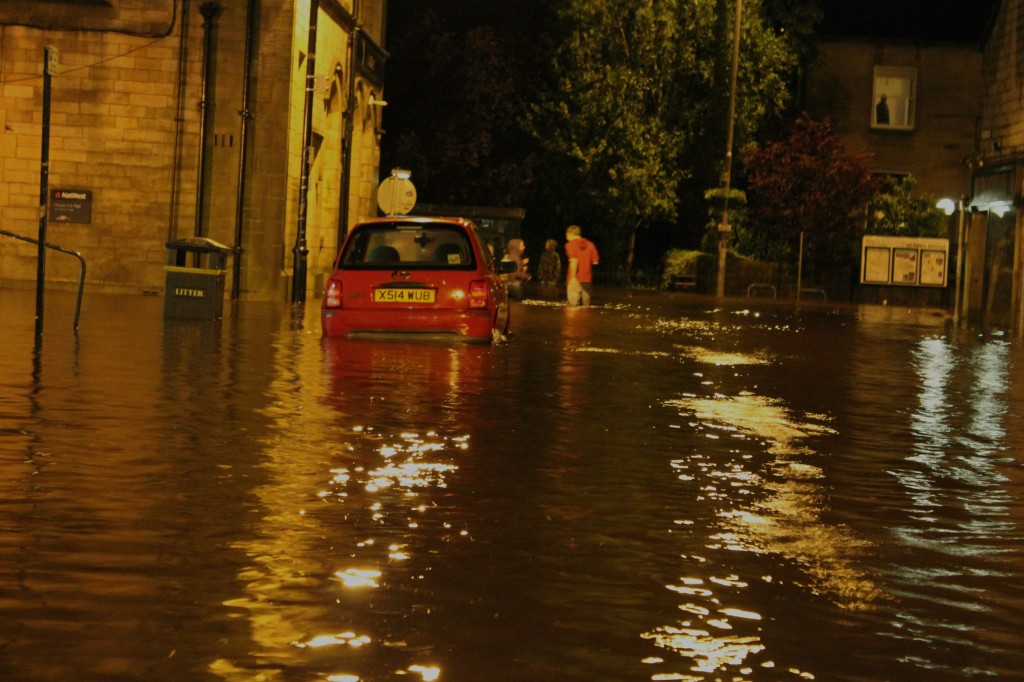Hebden Bridge residents and Calderdale Council both want Natural England to make sure that uplands management reduces the risk of flooding in the Upper Calder Valley.
In a submission to Natural England’s Uplands Review, more than 90 Hebden Bridge Residents have asked Natural England to urgently review the terms of the Walshaw Moor Estate Environmental Stewardship Agreement (ESA). The residents say that the ESA doesn’t take proper account of local people’s needs for upland management that will reduce the risk of flooding in the Upper Calder Valley, and as a result, the £2.5m that the ESA will pay to Walshaw Moor Estate over the next ten years “represents exceptionally poor value for public money.”
The Hebden Bridge residents’ submission to the Uplands Review explains that,
“…we consider good catchment management to be essential for the economic and social well-being of our community. In particular we want to see healthy blanket bog, with sphagnum moss to act as a natural buffer impeding the flow of run-off in heavy rainfall events. Sphagnum can hold up to 20 times its dry weight of water so it can ‘play a significant role in moderating water flow and thus helping to reduce downstream impacts of heavy rain’ (International Union for Nature Conservation Commission on UK Peatlands).”
Reasons for the Uplands Review – to work more effectively with farmers and grouse moor managers
Natural England’s Uplands Review follows its abandonment of the Vital Uplands policy it launched in 2009.
It ditched its Vital Uplands policy following Coalition government cuts to Natural England’s budget and the removal of its power to make policy – part of the Coalition’s “bonfire of the quangos” shortly after it came to power in 2010. In a statement about why Natural England ditched its Vital Uplands policy, Chairman Paul Christensen indicated that this was a Coalition government decision.
“The Government has made it very clear that it wants Natural England to work effectively with farmers and grouse moor managers to deliver multiple benefits in the uplands and so we have decided that we should signal a clear move away from a document which has been interpreted by some as a Natural England policy statement….we have established a new Upland Delivery Review Programme. This will help us make a fresh start by providing clarity about our role and remit, about the outcomes we are seeking and about the evidence we will use…”
Hebden Bridge residents aren’t the only people who think that Natural England should make sure that upland areas are managed in ways that will reduce flood risk in the Upper Calder Valley.
Natural England itself says that blanket bog is significant in “its ability to reduce flood risk downstream through slowing hydrological pathways”. Issues for the future include the fact that
“much of the blanket bog in England is degraded to some degree and its condition is greatly influenced by activities such as drainage, managed burning and heavy grazing. These can damage the hydrology and properties of the peat, which in turn lead to loss of structural and floristic diversity (especially peat-forming species) of the blanket bog.”
Calderdale Council: working with Natural England to reduce flood risks
Calderdale Council is committed to working with Natural England to make sure that these issues are addressed. In the aftermath of the two big June and July floods in the Upper Calder Valley, Councillor Steve Sweeney spoke to Energy Royd about the need for a different kind of flood alleviation scheme, that would reduce the torrential run off from the hillsides above the valley.
Marie Fallon, Calderdale Council’s recently-appointed Flood Programme Manager, has confirmed that Calderdale Council is now acting on the Environment Agency’s 2011 Preliminary Flood Risk Assessment for Calderdale recommendations. They include the need for the Council to:
- build a better rapport with Natural England in relation to the potential use of land management techniques in upland areas to reduce future flood risk
- establish protocols together with Natural England, to enable land management of moors to “proceed in a more flood friendly way”
Marie Fallon said,
“Natural England is a member of the new Environment and Infrastructure sub-group of the Upper Calder Valley Joint Flood Group – aka the Operational Group. The Environment and Infrastructure sub-group has had its initial meeting and is starting to work up proposals that will include how moorland management can reduce flood risks. The proposals will be available to the public online, or by contacting John O’Grady, Calderdale Council’s new Flood Resilience Team Communications Manager.”
John O’Grady added that he will be happy to share information about the sub-group’s work as it becomes available.
“The work we are doing on flood recovery and resilience remains at the embryonic stage and is still being developed. There is a lot of work to move through to establish basic principles with all the different partners. We are very much running with an inclusive mentality, working cooperatively and on a coordinated basis. Naturally, we have to give everyone (group and organisation) an opportunity to engage and make a contribution and this does take time.”
Calderdale Council has set up the Upper Calder Valley Joint Flood Group (aka Operational Group) in order to gather as much information as possible about the June and July floods, as a basis for working out what the Council can do to reduce and defend against flooding. The group brings together Calderdale MBC, the Environment Agency, Yorkshire Water, Network Rail and the Canal & River Trust (formerly British Waterways).

